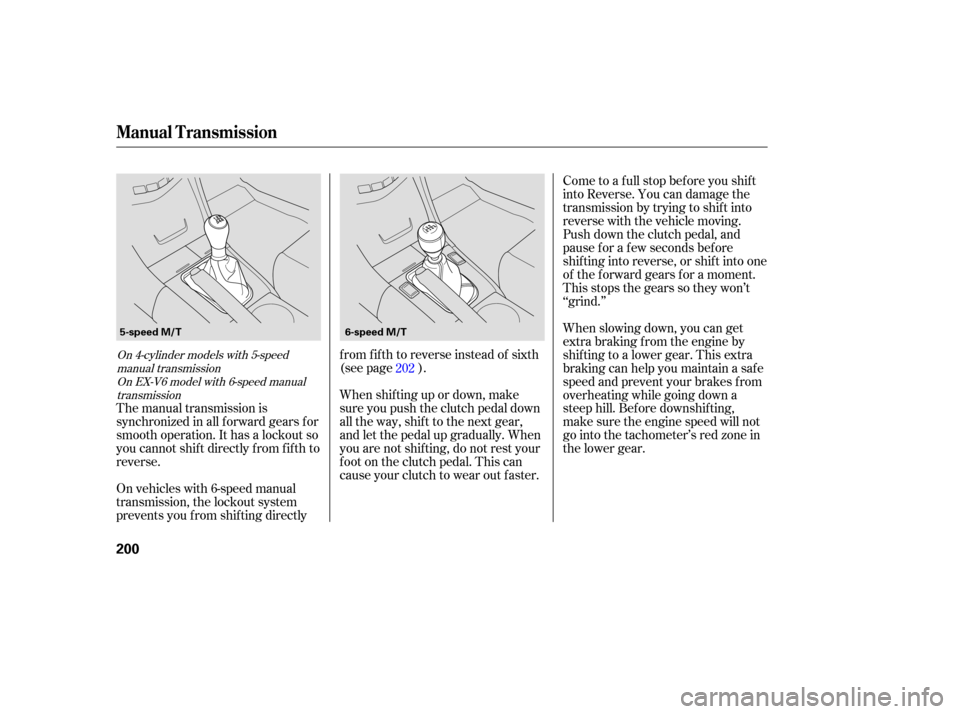Page 194 of 319

Some examples are:Larger or smaller wheels and tires
can interf ere with the operation of
your vehicle’s anti-lock brakes and
other systems.
If you plan to modif y your vehicle,
consult your dealer. Modif ying your steering wheel or
any other part of your vehicle’s
safety features can make the
systems inef f ective.
Removing parts f rom your vehicle,
or replacing components with
non-Honda components could
seriously af f ect your vehicle’s
handling, stability, and reliability.
Lowering your vehicle with a
non-Honda suspension kit that
signif icantly reduces ground
clearance can allow the
undercarriage to hit speed bumps
or other raised objects, which
could cause the airbags to deploy.
Raising your vehicle with a
non-Honda suspension kit can
af f ect the handling and stability.
Non-Honda wheels, because they
are a universal design, can cause
excessive stress on suspension
components.
Modif ying Your Vehicle
A ccessories and Modif ications
192
�����—�����—�����y�
�������������y���
�(���%�������y���
�����y
Page 199 of 319
This section gives you tips on
starting the engine under various
conditions, and how to operate the
manual and automatic transmissions.
It also includes important
information on parking your vehicle,
the braking system, the vehicle
stability assist (VSA) system, and
f acts you need if you are planning to
tow a trailer.........................
Preparing to Drive .198
.......................
Starting the Engine .199
...................
Manual Transmission .200
..............
Automatic Transmission .203
...........................................
Parking .207
.............................
Braking System .208
...............
Anti-lock Brakes (ABS) .209
Vehicle Stability Assist (VSA)
........................................
System .211
...........................
Towing a Trailer .213
Driving
Driving
197
�����—�����—�����y�
�������������y���
�(���%�������y���������y
Page 201 of 319

Apply the parking brake.
In cold weather, turn off all
electrical accessories to reduce
the drain on the battery.
Push the clutch pedal down all the
way. The START (III) position
does not function unless the clutch
pedal is pressed.
Make sure the shift lever is in
Park. Press on the brake pedal. If
the engine does not start within
15 seconds, or starts but stalls
right away, repeat step 4 with the
accelerator pedal pressed halfway
down. If the engine starts, release
pressure on the accelerator pedal
so the engine does not race.
If the engine fails to start, press
the accelerator pedal all the way
down, and hold it there while
starting to clear flooding. If the
engine still does not start, return
to step 5.
Without
touching the accelerator
pedal, turn the ignition key to the
START (III) position. Do not hold
the key in the START (III)
position for more than 15 seconds
at a time. If the engine does not
start right away, pause for at least
10 seconds before trying again.
1.
2.
3.
4.
5.
6.
Manual Transmission:
Automatic Transmission:
75
Starting theEngine
Driv ing
199
The engine is harder to start in cold
weather. Also, the thinner air found at
altitudes above 8,000 feet (2,400
meters) adds to this problem.
T he immobilizer system protects your
vehicle f rom thef t. If an improperly-
coded key (or other device) is used, the
engine’s f uel system is disabled. For
more inf ormation, see page .
�����—�����—�����y�
�������������y���
�(���%�������y���������y
Page 202 of 319

The manual transmission is
synchronized in all forward gears for
smooth operation. It has a lockout so
you cannot shift directly from fifth to
reverse.
On vehicles with 6-speed manual
transmission, the lockout system
prevents you from shifting directly from
fifth to reverse instead of sixth
(see page ).
When shif ting up or down, make
sure you push the clutch pedal down
all the way, shif t to the next gear,
and let the pedal up gradually. When
you are not shif ting, do not rest your
f oot on the clutch pedal. This can
cause your clutch to wear out f aster. Come to a full stop before you shift
into Reverse. You can damage the
transmission by trying to shift into
reverse with the vehicle moving.
Push down the clutch pedal, and
pause f or a f ew seconds bef ore
shif ting into reverse, or shif t into one
of the f orward gears f or a moment.
This stops the gears so they won’t
‘‘grind.’’
When slowing down, you can get
extra braking from the engine by
shifting to a lower gear. This extra
braking can help you maintain a safe
speed and prevent your brakes f rom
overheating while going down a
steep hill. Bef ore downshif ting,
make sure the engine speed will not
go into the tachometer’s red zone in
the lower gear.
202
On 4-cylinder models with 5-speed
manual transmissionOn EX-V6 model with 6-speed manualtransmission
Manual T ransmission
200
5-speed M/T 6-speed M/T
�����—�����—�����y�
�������������y���
�(���%�������y���������y
Page 204 of 319

If you exceed the maximum speed
f or the gear you are in, the engine
speed will enter into the tachometer’s
red zone. If this occurs, you may f eel
the engine cut in and out. This is
caused by a limiter in the engine’s
computer controls. The engine will
run normally when you reduce the
rpm below the red zone.
Bef ore downshif ting, make sure the
engine will not go into the
tachometer’s red zone.The manual transmission has
lockout so you cannot accidentally
shif t f rom f if th to reverse instead of
sixth while the vehicle is moving. If
you cannot shif t to reverse when the
vehicle is stopped:
With the clutch pedal pressed,
move the shift lever to the first/
second gear side of the neutral
gate, then shif t to reverse. If you are still unable to shif t to
reverse, apply the parking brake,
and turn the ignition key to the
ACCESSORY (I) or LOCK (0)
position.
Press the clutch pedal, and shif t to
reverse.
With the clutch pedal still pressed,
start the engine.
If you need to use this procedure to
shif t to reverse, your vehicle may be
developing a problem. Have the
vehicle checked by your dealer.
1. 2.
3.
4.6-speed manual transmission only
Engine Speed L imiter
Reverse L ockout
Manual T ransmission
202
�����—�����—�����y�
���������
���y���
�(���%�������y���������y
Page 205 of 319
These indicators between the tacho-
meter and speedometer show which
position the shif t lever is in.The ‘‘D’’ indicator comes on f or a
f ew seconds when you turn the
ignition switch to the ON (II)
position. If it f lashes while driving (in
any shif t position), it indicates a
possible problem in the transmission.
If the malf unction indicator lamp
comes on along with the ‘‘D’’
indicator, there is a problem in the
automatic transmission control
system. Avoid rapid acceleration, and
have the transmission checked by
your dealer as soon as possible.
To shif t f rom any position to Park,
pressfirmlyonthebrakepedal,and
pressthereleasebuttononthefront
of the shif t lever. You cannot shif t
out of Park when the ignition switch
is in the LOCK (0) or the
ACCESSORY(I) position.
CONT INUED
Shif ting
Shif t L ever Position Indicators
Automatic Transmission
Driving
203
SHIFT LEVER
RELEASE BUTTON
�����—�����—�����y�
�������������y���
�(���%�������y���������y
Page 206 of 319

�µ
�µ�µ
To
shift from:
PtoR
RtoP
NtoR
Dto2 2to1
1to2
2toD
DtoD DtoN
DtoD NtoDRtoN Do
this:
Press the brake pedal and
press the release button.
Press the release button.
Move the lever.
3
3
3
3
If you have done all of the above and
still cannot move the lever out of
Park, see on
page .
You must also press the release
button to shift into Park. To avoid
transmission damage, come to a
complete stop bef ore shif ting into
Park. The shif t lever must be in Park
bef ore you can remove the key f rom
the ignition switch. Use neutral if you
need to restart a stalled engine, or if
it is necessary to stop brief ly with
the engine idling. Shif t to the Park
position if you need to leave your
vehicle for any reason. Press on the
brake pedal when you are moving
the shift lever from neutral to
another gear.
This position mechani-
cally locks the transmission. Use
Park whenever you are turning of f or
starting the engine. To shif t out of
Park, you must press on the brake
pedal and have your f oot of f the
accelerator pedal. Press the release
buttononthefrontof theshiftlever
to move it. Press the brake
pedal and press the release button
on the f ront of the shif t lever to shif t
f rom Park to reverse. To shif t f rom
reverse to neutral, come to a
completestopandthenshift.Press
the release button bef ore shif ting
into reverse f rom neutral.
206
Automatic Transmission
Shif t L ock Release Neutral (N)
Park (P) Reverse (R)
204
�����—�����—�����y�
�����������
�y���
�(���%�������y���������y
Page 208 of 319

This allows you to move the shif t
lever out of Park if the normal
method of pushing on the brake
pedal and pressing the release
button does not work.Set the parking brake.
Remove the key from the ignition
switch.
Push down on the key while you
pressthereleasebuttononthe
shif t lever and move the shif t lever
out of Park to neutral. Insert the key in the shift lock
release slot.Remove the key from the shift
lock release slot, then reinstall the
cover. Make sure the notch on the
cover is on the lef t side. Press the
brake pedal, and restart the engine.
If you need to use the shif t lock
release, it means your vehicle is
developing a problem. Have it
checked by your dealer.
Putaclothonthenotchof the
shif t lock release slot cover. Using
a small f lat-tipped screwdriver or a
metal f ingernail f ile, caref ully pry
on the notch of the cover to
remove it.
1.
2.
3.
4.
5.6.
Shif t L ock Release
Automatic Transmission
206
COVER
RELEASE
BUTTON
SHIFT LOCK RELEASE SLOT
NOTCH
�����—�����—�����y�
�������������y���
�(���%�������y���������y